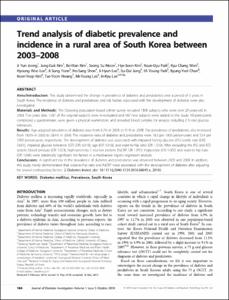KUMEL Repository
1. Journal Papers (연구논문)
1. School of Medicine (의과대학)
Dept. of Internal Medicine (내과학)
Trend analysis of diabetic prevalence and incidence in a rural area of South Korea between 2003–2008
- Keimyung Author(s)
- Kim, Hye Soon; Park, Keun Gyu; Lee, Mi Young
- Journal Title
- Journal of Diabetes Investigation
- Issued Date
- 2010
- Volume
- 1
- Issue
- 5
- Keyword
- Diabetes mellitus; Prevalence; South Korea
- Abstract
- Aims/Introduction: This study determined the change in prevalence of diabetes and prediabetes over a period of 5 years in
South Korea. The incidence of diabetes and prediabetes and risk factors associated with the development of diabetes were also
investigated.
Materials and Methods: The Dalseong population-based cohort survey recruited 1806 subjects who were over 20-years-old in
2003. Five years later, 1287 of the original subjects were re-evaluated and 187 new subjects were added to the study. All participants
completed a questionnaire, were given a physical examination, and provided blood samples for analysis including 2 h oral glucose
tolerances.
Results: Age-adjusted prevalence of diabetes rose from 6.7% in 2003 to 9.1% in 2008. The prevalence of prediabetes also increased
from 18.5% in 2003 to 28.4% in 2008. The incidence rates of diabetes and prediabetes were 18.3 per 1000 person-years and 55.4 per
1000 person-years, respectively. The development of diabetes was associated with impaired fasting glucose (IFG) (odds ratio [OR]
5.661), impaired glucose tolerance (IGT) (OR: 6.013), age (OR 1.013), and waist-to-hip ratio (OR 1.513). After excluding the IFG and IGT,
systolic blood pressure (OR 1.023), high-sensitivity C-reactive protein (hsCRP; OR 1.097), triglyceride (OR 1.002) and waist-to-hip ratio
(OR 1.696) were statistically significant risk factors in a multivariate logistic regression analysis.
Conclusions: A significant rise in the prevalence of diabetes and prediabetes was observed between 2003 and 2008. In addition,
this study newly demonstrated that waist-to-hip ratio and hsCRP were associated with the development of diabetes after adjusting
for several confounding factors.
- Publisher
- School of Medicine
- Citation
- Ji Yun Jeong et al. (2010). Trend analysis of diabetic prevalence and incidence in a rural area of South Korea between 2003–2008. Journal of Diabetes Investigation, 1(5), 184–190. doi: 10.1111/j.2040-1124.2010.00045.x
- Type
- Article
- ISSN
- 2040-1116
- 파일 목록
-
-
Download
 oak-aaa-2660.pdf
기타 데이터 / 152.41 kB / Adobe PDF
oak-aaa-2660.pdf
기타 데이터 / 152.41 kB / Adobe PDF
-
Items in Repository are protected by copyright, with all rights reserved, unless otherwise indicated.